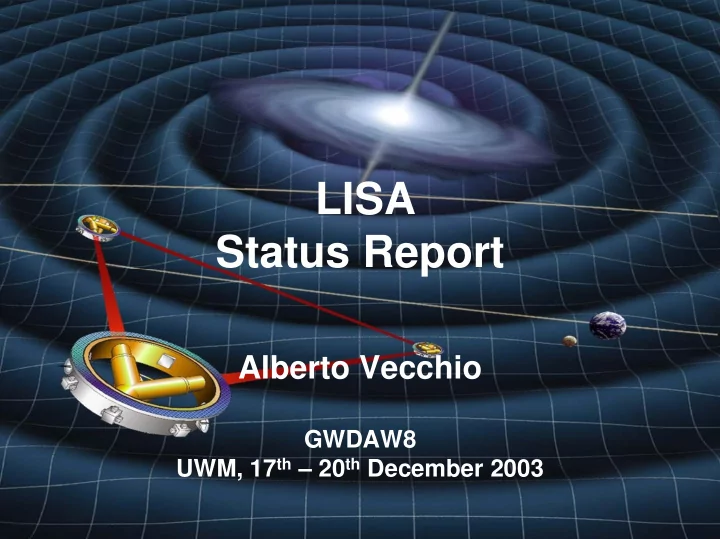

LISA Status Report Alberto Vecchio GWDAW8 UWM, 17 th – 20 th December 2003
Outline • LISA – Status of the project – LISA Pathfinder: SMART-2 • Data analysis challenges – Band “cleaning” – Extreme mass ratio binary systems – Foregrounds detection • The long term future: Big Bang Observer GWDAW8 – UWM, 17 th – 20 th December 2003 A Vecchio – LISA: Status report
LISA: the instrument • 3 pairs of “free falling” test masses: 3x10 -15 ms -2 Hz -1/2 @ Spacecrafts 0.1 mHz • 3 “test-mass follower” shielding spacecraft 2 semi-independent 5x10 6 km • Test Michelson Interferometers Masses with Laser Transponders: 40 pm Hz -1/2 Telescopes • Goal: GW observations at 0.1 5 10 6 km mHz – 0.1 Hz − ≈ × 21 -3 Strain sensitivity 3 10 Hz @ 10 Hz GWDAW8 – UWM, 17 th – 20 th December 2003 A Vecchio – LISA: Status report
Multiple observables One can synthesise 6 independent beams different observables (Tinto et al, 2000) Symmetrized-Sagnac allows noise calibration GWDAW8 – UWM, 17 th – 20 th December 2003 A Vecchio – LISA: Status report
LISA: the orbit • Vast majority of LISA sources are long lived • Amplitude and phase modulations introduced by the instrument motion allow reconstruction of source position GWDAW8 – UWM, 17 th – 20 th December 2003 A Vecchio – LISA: Status report
Observational window Acceleration Advanced noise resonant Arm length Optical path noise GWDAW8 – UWM, 17 th – 20 th December 2003 A Vecchio – LISA: Status report
Testing quality of free fall 10 -12 ⎛ ⎞ N S Torsion pendulum ⎜ ⎟ F ⎝ ⎠ Hz (surface disturbances) 10 -13 (Carbone et al, 2003) LISA Pathfinder 10 -14 (SMART-2) 10 -15 LISA GWDAW8 – UWM, 17 th – 20 th December 2003 A Vecchio – LISA: Status report
Sources D ~ 1 Gpc Galactic and z<1 1<z<30 t ~ 10 -10 sec GWDAW8 – UWM, 17 th – 20 th December 2003 A Vecchio – LISA: Status report
Guaranteed detection 19 know n galactic binaries 19 know n galactic binaries “Calibration sources” “Calibration sources” Actually many more: (Nelemans et al, 2001; Nelemans, 2003) GWDAW8 – UWM, 17 th – 20 th December 2003 A Vecchio – LISA: Status report
Data analysis challenges • Cleaning of the observational band • Observations of in-spirals from extreme mass ratio binary systems • Noise “calibration”: unambiguous detection of astrophysical foregrounds GWDAW8 – UWM, 17 th – 20 th December 2003 A Vecchio – LISA: Status report
Band cleaning • Important to make resolved sources as visible as possible • First go at the problem: gCLEAN (Cornish and Larson, 2003) – Works for isolated Stochastic foreground sources – Not quite for (Nelemans et al, 2001) overlapping sources GWDAW8 – UWM, 17 th – 20 th December 2003 A Vecchio – LISA: Status report
WD extra-galactic foreground Is NS-NS foreground an issue? (PSR J 0737-3039) (Farmer and Phinney, 03) GWDAW8 – UWM, 17 th – 20 th December 2003 A Vecchio – LISA: Status report
Extreme mass ratio binaries • “Dream signal” for a theorist: point particle – WD, NS, low mass BH - in completely generic (eccentric, non- equatorial, spins) orbit around a Kerr black hole – Number of cycles in a yr ~ a few 10 5 • General Relativity : – Map of the black hole spacetime (Ryan, 1996) – Test “no-hair theorem” • Astrophysics : – Dynamics in galaxy cores – MBH’s demographics and properties – Mass distribution, isotropy, dispersion of “swarms” GWDAW8 – UWM, 17 th – 20 th December 2003 A Vecchio – LISA: Status report
LISA and EMR binaries D = 1 Gpc • Event rate is good if we assume nearly optimal filtering : SNR ~ 30 for 1 yr of coherent integration • Signals fight against confusion noise and each others (Finn and Thorne, 2000; Barak and Cutler, 2003) GWDAW8 – UWM, 17 th – 20 th December 2003 A Vecchio – LISA: Status report
The challenge • Waveform computation – In principle the theoretical problem is very well posed: perturbation theory (“point” particle around massive black hole:Teukolsky formalism) – Prescription for rigorous radiation reaction available (Mino et al, 1997; Quinn and Wald, 1997) – Emphasis is on implementation: we need waveforms • Data analysis – Check SNR loss – Estimate number of filters – Design effective/efficient search strategy GWDAW8 – UWM, 17 th – 20 th December 2003 A Vecchio – LISA: Status report
EMR in-spirals The approach: What have we learned: • Generate incorrect • Naive calculation gives ~10 20-30 filters: no way (“kludge”) waveforms that capture the key behaviour • However one can: of the signal (Glampedakis, – Exploit correlations among Hughes, Kennefick, 2002; templates Hughes, 2001,02; Barak – Use a sub-optimal hierarchical and Cutler, 2003) approach • Preliminary results are • Use kludge waveforms to actually very encouraging gain insight into the (T. Creighton&Gair and problem Barak&Cutler) GWDAW8 – UWM, 17 th – 20 th December 2003 A Vecchio – LISA: Status report
LISA and foregrounds • Detection of (isotropic) stochastic signals depends on LISA multiple readouts – Several ways of recombining the readouts, e.g. “symmetrized-Sagnac” (Tinto et al, 00) – Michelson+Sagnac: detection of the isotropic component with one instrument • Substantial progress in understanding multiple readouts (Caltech/JPL and Pune/Nice groups) (Hogan and Bender, 2001) GWDAW8 – UWM, 17 th – 20 th December 2003 A Vecchio – LISA: Status report
Big Bang Observer (~2025) GWDAW8 – UWM, 17 th – 20 th December 2003 A Vecchio – LISA: Status report
Conclusions • LISA in on track for launch in 2012 • Encouraging progress on all the key data analysis issues • … but still a lot of work to do GWDAW8 – UWM, 17 th – 20 th December 2003 A Vecchio – LISA: Status report
Recommend
More recommend